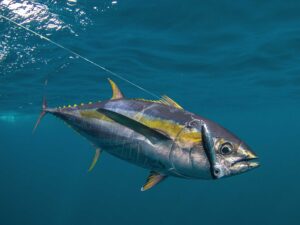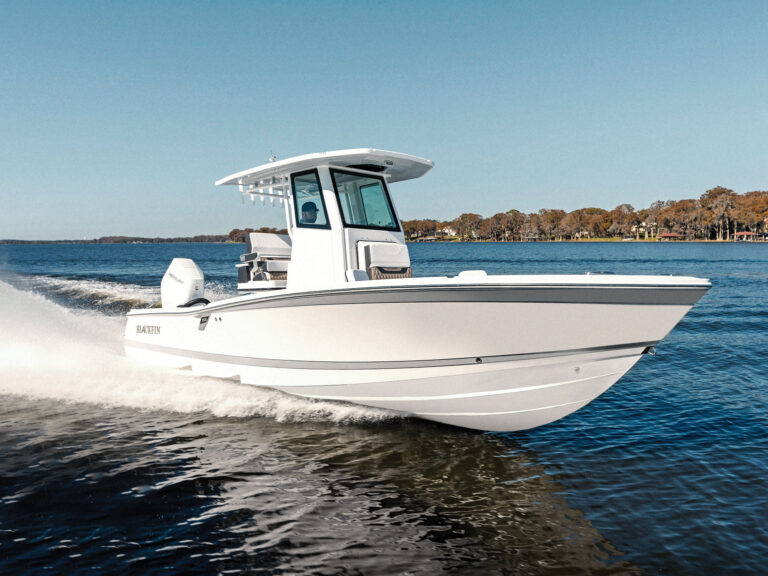
Florida tarpon fishing is as diverse as the state’s waters. Different fisheries shine at different phases of the species’ annual turns along the coasts. Together, four fisheries for four seasons tell something of the mystery—and magic—of the tarpon’s life story.
Spring’s Tarpon Migration in the Keys

To track spring tarpon, Capt. Juan Garcia of Islamorada heads to the western edges of Everglades National Park in Florida Bay, to Cape Sable, and a bit up the coast toward Shark River. He’ll also scout schools deeper in the Gulf.
“It can be pretty epic on a slicked-out day when you find hundreds of tarpon laying up on the surface,” Garcia says. “When the water temperature starts to hold steady in the mid-70s, these fish move deeper into the park. Tides, water temperature, wind direction and weather determine the best areas to fish on a given day.”
Garcia believes the fish come from the northern and western Gulf of Mexico, and some research has revealed that huge schools of tarpon overwinter around oil rigs in the northern Gulf.
“These fish are ready to feed and get into their spawning rituals in the coming months. The longer they’re around, the more pressure they see from anglers, so we’re on the lookout. We like to get the first jump,” Garcia says.

He selects his tackle depending on the size of tarpon he’s after, always keeping in mind that a fast fight and a quick release are good for the fish and the fishery. When he’s fishing dead baits such as mullet on the bottom, he’ll use a weight, swivel and a circle hook attached to a 5-foot fluorocarbon leader. The weight and leader sizes depend on the current and water clarity.
“Up in the Flamingo and Cape Sable area, you can’t beat mullet or ladyfish,” he says. “Pilchards, pinfish and shrimp work well for the smaller fish. At the bridges, I use mullet, dead or alive, depending on tide and location. When the sun goes down, live medium crabs are my bait.”
- Rod: Penn 30- to 80-pound-class jig spinning rod, or equivalent
- Reel: 6500 Spinfisher, or equivalent
- Line: 40-pound braid, 80-pound mono leader
- Terminal: 5/0 to 8/0 circle hook
- Bait: Live crabs, pilchards, pinfish, mullet and shrimp; plugs or jigs that look similar
Summer’s Tarpon Spawning Grounds
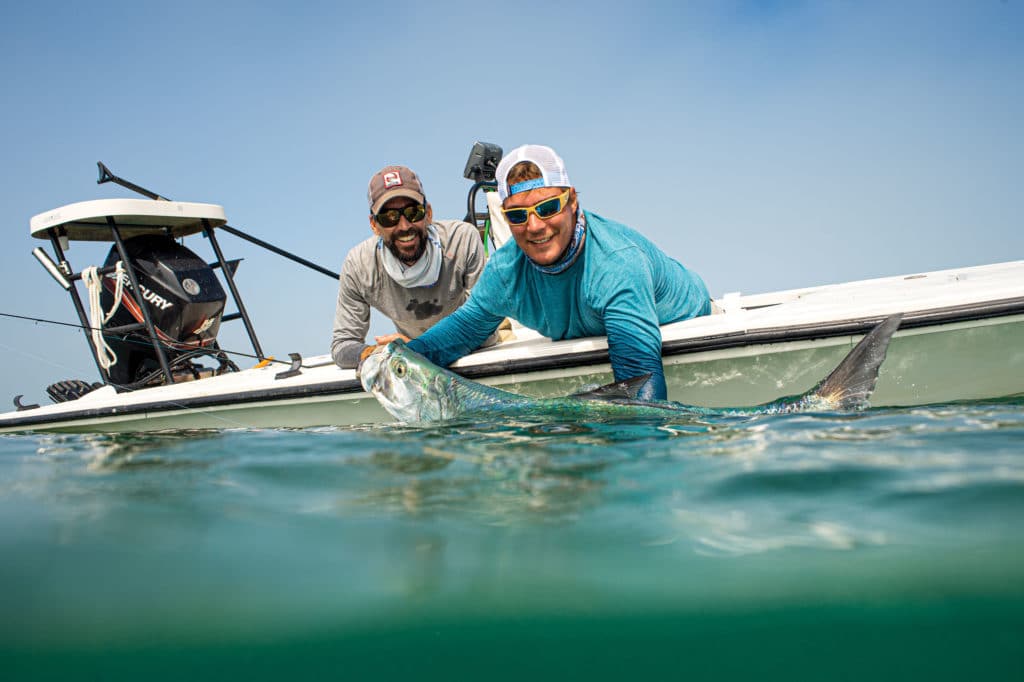
As spring days pass, schools of tarpon move northward to their spawning grounds. Boca Grande is one famous spring fishery, but tarpon are well-distributed along Florida’s southwest coast all summer.
“There’s nothing better than a school of tarpon that has rested up all night and is ready to chew at the crack of dawn,” says Capt. David Holzhauer of Cape Coral. Holzhauer’s fishing begins in the spring with the first wave of fish, and continues deep into summer.
“Their northerly pattern brings them into the Fort Myers Beach and Sanibel area from deep water, where they stage before continuing along the beaches toward Captiva Island, Boca Grande, and farther north toward Tampa,” Holzhauer says. “Along with staying in the Gulf, the fish also take the inside track through the Intracoastal up Pine Island Sound, where the fishing can be as impressive as on the outside Gulf waters.”
Tracking bottom contours is critical, he adds. Knowing where the slightest drop-offs are, where the bottom changes, or where structure lies determines whether or not the fish will pass within reach of your bait and stay around long enough to give you multiple hookup chances.
- Rod: 7-foot, 6-inch Tsunami jigging rod, or equivalent rod with large guides and long forward grip
- Reel: Tsunami STX6000 or equivalent
- Line: 50-pound braid, 60- to 80-pound fluoro leader
- Terminal: 4/0 to 9/0 Trokar TK3
- Bait: Live threadfins, crabs or mullet, dead catfish
Autumn Forage Baitfish for Tarpon
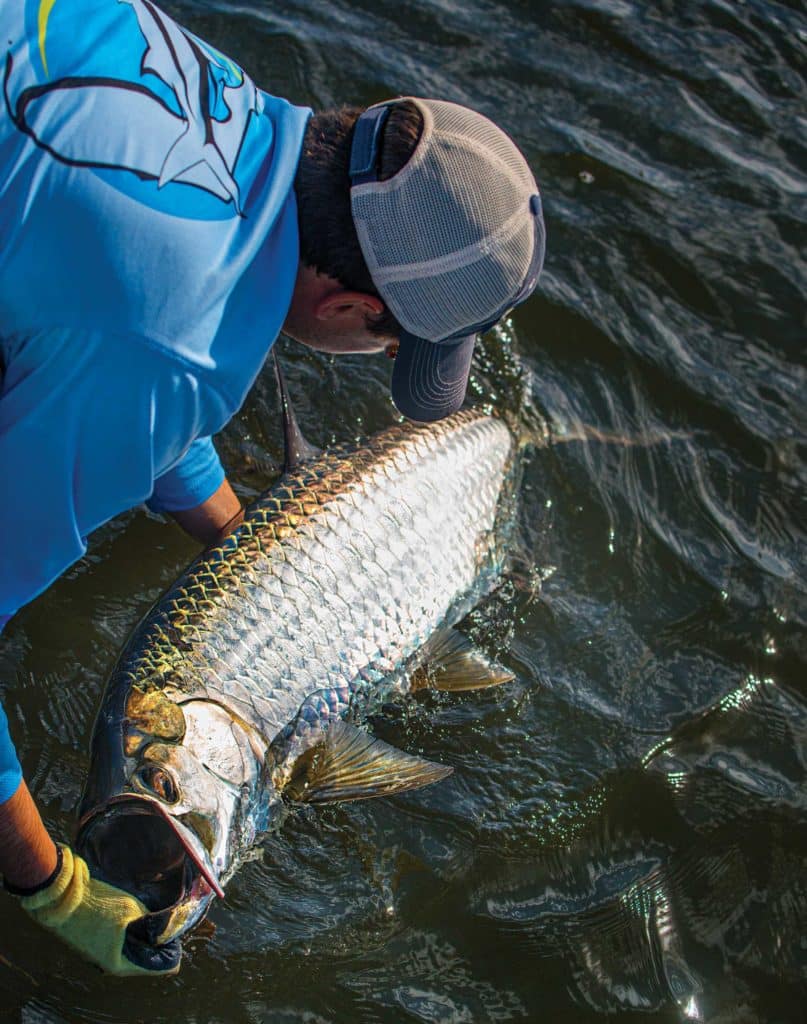
Fall action kicks into gear with the outpouring of mullet, pogies and minnows through the inlets to the nearby beach waters, in a southward migration.
“In the fall, we target the inlets, bridges and beaches for the bigger migrating tarpon,” says Capt. Tommy Derringer, a practiced hand at tarpon from South Jacksonville to Palm Coast. “My favorite place to target big fish would have to be the inlets. The tarpon put on quite a show along the rocks, and if you time it right, it can be an all-out feeding frenzy.”
Float a live bait, free-line, fish the bottom, or even toss a plug or fly at those fish, Derringer says, and the action gets outrageous. “There might be three to five big tarpon going airborne, attacking the mullet schools as you fish. If that scene doesn’t get your heart pumping, I don’t know what will.”
Derringer cautions that the area’s high tides, 4 to 6 feet on average, cause big currents, which can make it tough “to get a live bait to look natural in the water. If your bait looks even a little unnatural, tarpon are most likely going to pass on it.” As the pods wend their way south, tarpon can also be reached with a good, hard cast from some beaches.
- Rod: Shimano 7-foot, 7-inch rod, or equivalent lightweight spinner with fast action and backbone
- Reel: Shimano Saragosa 8000, or equivalent spinning reel
- Line: 40-pound braid with 40- to 60-pound fluorocarbon leader
- Terminal: 6/0 to 10/0 Trokar circle hook or equivalent, sized to bait
- Bait: Live mullet is often best in fall, also plugs, soft plastics and jigs
Winter in the Big City
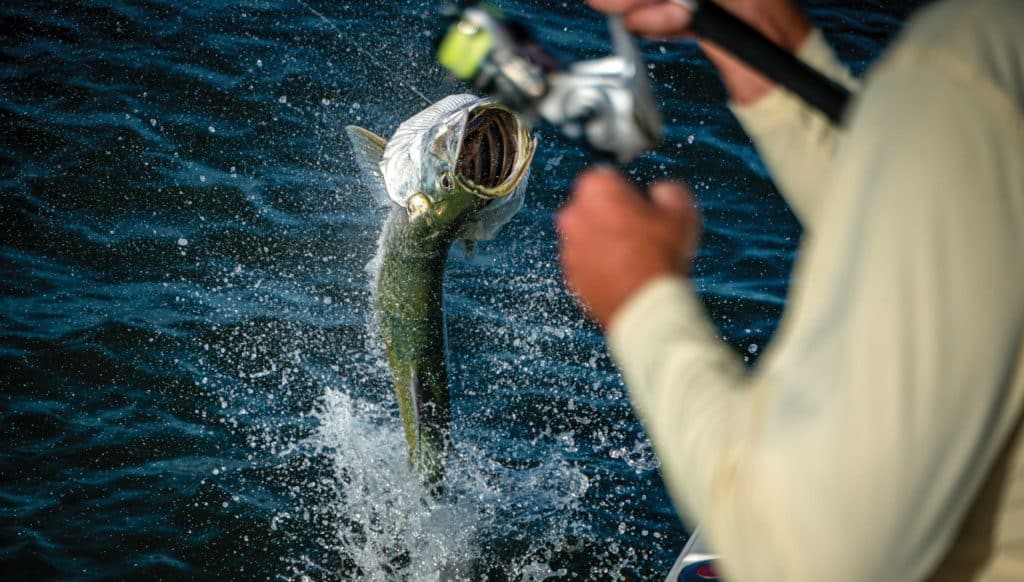
From December through February, Capt. Dave Kostyo of Miami catches tarpon in Haulover Inlet and along the beaches north and south of there. Under the lights of Miami, Kostyo heads out at night and targets the fish wintering in deeper water and feeding on the shrimp runs spurred on by winter cold fronts. Later in the year, from March into July, he will focus on fishing Government Cut. And he says many bridges in Biscayne Bay are good for tarpon throughout the entire season.
“In a four-hour trip,” Kostyo says, “I reasonably expect to have shots at anywhere from two to eight tarpon. When you hit an evening when the shrimp run, the action gets even better.”
Early in the season, the fish tend to be smaller specimens “from inside the bay, from the mangroves and brackish bays north of the inlet,” he explains.
After February, bigger fish move in, with April and May the best months for fish over 100 pounds. Still, there’s something magical about catching tarpon in the dead of winter, by a big city, with few other boats on the water.

Haulover Inlet is a drift fishery, and there’s skill to knowing how to drift your boat over the areas where the fish gather, not to mention how to maneuver once you’re hooked up. “No matter how well you know the area by day, it’s a whole different picture by night,” Kostyo says. “If a tarpon takes you into the main ship channel, remember, the big ships have the right of way. Also, keep your navigation lights on, and be aware of where the jetties are when moving toward a hooked tarpon.”
Kostyo has a few words for anglers who want a shot but are as yet unfamiliar with the tarpon’s power: “Stand up and breathe while fighting the fish. I’ve seen many anglers bent over at the waist, cutting off their breathing. They get exhausted and have to pass the rod off. On the bigger tarpon, your back is going to hurt, your arms will turn to rubber, and your grip will give out.”
- Rod: 7-foot, medium -ction, rated for 20- to 30-pound braid
- Reel: Penn Spinfisher 6500 or equivalent
- Line: 30- to 50-pound mono top shot, 50-pound leader
- Terminal: 7/0 or 8/0 non-offset circle hook
- Bait: Shrimp in the winter



